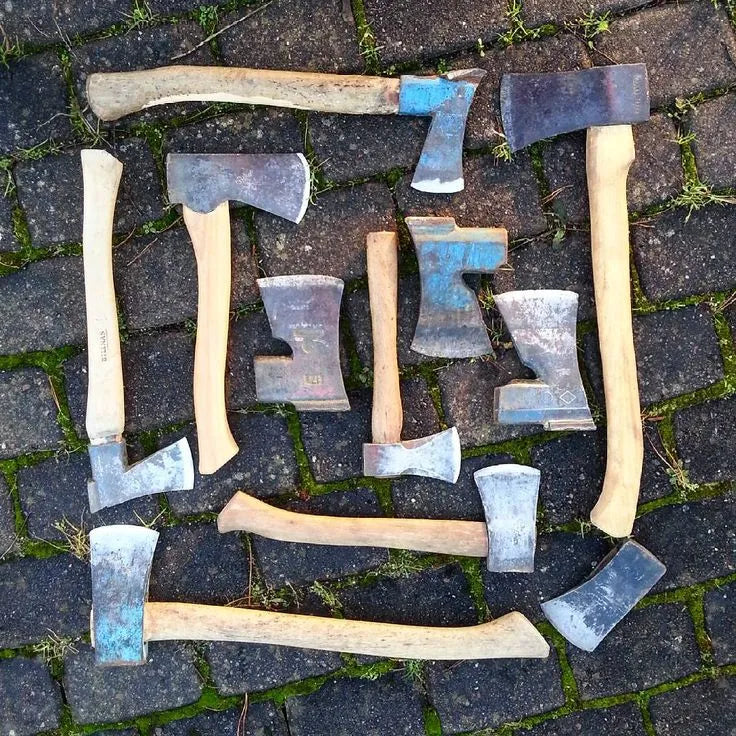
Are All Axes the Same?
Axes are considered some of the earliest tools ever used by humans. They are simple in design yet offer efficient working. However, one often-asked question is: Are all axes the same? The simplest answer: No!
To find out why, it is necessary to examine the complex structure of an axe. The functions of each component are distinct. The differences in these components correspond to the intended usage of the axe.
Not all axes have the same parts or designs. Knives Hives explains the fundamental anatomy of an axe to help you comprehend ‘Are all axes the same?’.
The Anatomy of an Axe
An axe's components have names derived from human anatomy. This analogy provides a relevant means of comprehending the instrument's structure.
Buy the best carbon steel axe.
HeadThe most important part of an axe is the head. It is the steel part that makes chopping easier. Modern axe heads were once fashioned of stone. However, they are now forged from sturdy steel that can withstand repeated contact.
Subparts of the Head
Eye
The handle runs through the eye, which is the primary opening in the skull. A wedge holds the head of axes with wooden handles in place so that it doesn't come loose while being used. The head is typically molded or forged as a single unit with a handle. Therefore, axes with composite or steel handles frequently do not have an eye.
Bit (or Blade)
The axe's cutting edge. Double-bit axes have two cutting edges, while single-bit axes only have one. Harder steel is frequently used to increase the bit's cutting effectiveness.
Toe and Heel
The cutting edge's toe and heel are at the top and bottom corners, respectively. Both enhance the cut's accuracy and effectiveness.
Beard
The concave part of an axe's head that extends beneath the bit is called the beard. The length varies based on the type of axe and its intended use. For instance, to hew wood, broad axes have lengthy beards.
Subparts of the Beard
Cheek
The cheek is situated on either side of the axe head. It gives the head its structural stability.
Poll (or Butt)
The poll is the back of the axe head. On single-bit axes, it is frequently employed as a hammering surface. Both endpoints of double-bit axes function as cutting edges. Therefore, they do not have a poll.
Handle (or Helve/Haft)
The handle offers control and leverage. Traditionally, it is made of wood, such as American hickory. Contemporary handles can alternatively be made of steel or composite materials.
Subparts of the Handle
Shoulder
The shoulder is situated directly behind the head. It frequently has a little curve for stability.
Belly
This is the handle's front part. Certain handles feature a convex curvature to improve grip and maneuverability.
Throat
The grip starts at the throat, close to the handle's end. It may be concave or straight.
Grip
The grip is designed to accommodate the user's hands, which is crucial for comfort and control.
Knob
The handle's flared end keeps the axe from sliding while in use.
Buy the real viking axe.
Are All Axes the Same?
No, not all axes are the same. Differences in design, substance, and purpose are the causes of variations. For instance:
Composite-Handled Axes
The handle encircles the head rather than going through it, so these axes often lack an eye.
Double-Bit Axes
Both ends act as cutting edge. They do not require a poll.
Specialized Bits
A splitting maul's bit is made for splitting wood. It is very different from a felling axe's bit used to cut trees.
These differences demonstrate how axes are designed for specific uses, such as splitting firewood or hewing lumber.
The Bottom Line
Now you know why ‘Are all axes the same?’.
Axes may appear simple, consisting of a head and a handle. However, their anatomy is far more complex. The range of components and designs reflects axes' various functions in forestry, woodworking, and other fields. Choosing the appropriate tool for the task requires an understanding of the anatomy of an axe, its components, and its variants. More significantly, using this strong instrument safely and appropriately is essential. Learning about the many kinds and applications of axes is a fulfilling experience. After all, comprehending the fundamentals of this ageless instrument is the first step toward mastering it!
Get the best, authentic Damascus steel axe.








